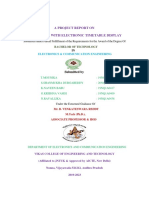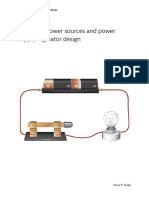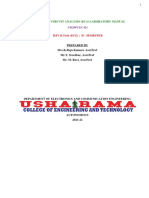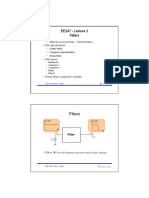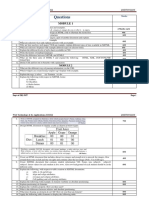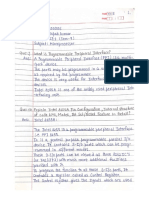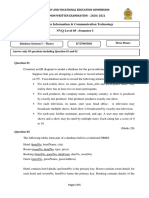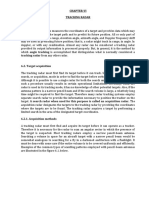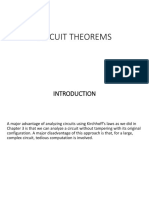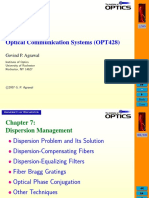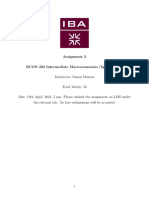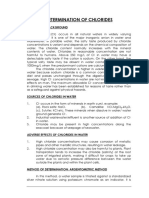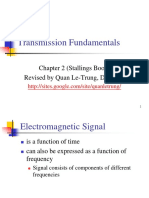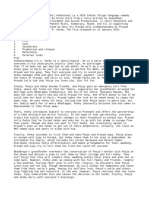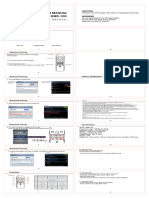BE Unit 1 KKnotes
Uploaded by
Jahannavi SinghBE Unit 1 KKnotes
Uploaded by
Jahannavi SinghBasic Electronics [EC 301] KK
Notes
Module I: Basic Electronic Components
Active and Passive Components,
Types of resistors and Colour coding,
Capacitor and Inductor,
Applications of Capacitors, Inductors Resistor,
Relay,
LDR,
Basic Integrated Circuits (IC 7805, 7809, 7812, 555 etc.).
Measuring Instruments like CRO,
Power supply,
Multi-meters etc.
Department of Electrical Engineering, RCIT, Bishrampur Page 1
Basic Electronics [EC 301] KK
Notes
Active components are the elements or devices which are capable of providing or delivering
energy to the circuit.
An active element is defined as the circuit component which can enhance the energy level of a
signal passing through it. Example: Vacuum Tube, battery and semiconductor devices such as
transistor, op-amp etc. are active element.
Passive components are the ones that do not require any external source for the operation and
are capable of storing energy in the form of voltage or current in the circuit.
In simple words, any circuit element which only consumes power is called passive element. It
cannot supply energy into the circuit. These components are incapable of providing any gain in
energy and current. In fact, these elements require active element in the circuit to work. Example:
resistor, inductor, capacitor, thermistor etc.
Resistor
Resistor is a passive electrical component with two terminals that are used for either limiting or
regulating the flow of electric current in electrical circuits. The main purpose of resistor is to
reduce the current flow and to lower the voltage in any particular portion of the circuit.
Resistance
The property of a substance which opposes the flow of electric current (or electricity) through it is
called Resistance OR Resistance is the ability of a circuit which opposes current. The unit of
resistance is OHM (Ω) where 1Ω = 1V/1A. Which is derived from the basic electrical Ohm’s law
V = IR.
Laws of Resistance:
1. If the temperature and other physical variables stay constant, the resistance of a conductor
is exactly proportional to its length.
R l
2. When all other variables are constant, the resistance of a conductor is inversely
proportional to the area of a cross-section i.e.
R
3. R is determined by the type of the conductor's substance. It implies that if we take equal
lengths of wires made of copper, aluminum, and iron with the same cross-sectional area,
their resistance will differ since they are made of various materials.
So from above two equations we have
Department of Electrical Engineering, RCIT, Bishrampur Page 2
Basic Electronics [EC 301] KK
Notes
R and R=
Where is rho is a constant known as resistivity or specific resistance of the material. The
reciprocal of the resistance is called conductance.
Types of Resistors:
Resistors are available in different size, Shapes and materials.
There are two basic types of resistors.
1. Linear Resistors
2. Non Linear Resistors
Department of Electrical Engineering, RCIT, Bishrampur Page 3
Basic Electronics [EC 301] KK
Notes
Linear Resistors:
Those resistors, which values change with the applied voltage and temperature, are called linear
resistors. In other words, a resistor, which current value is directly proportional to the applied
voltage is known as linear resistors. Generally, there are two types of resistors which have linear
properties.
1. Fixed Resistors
2. Variable Resistors
Fixed Resistors
As the name tells everything, fixed resistor is a resistor which has a specific value and we can’t
change the value of fixed resistors.
Types of Fixed resistors
1. Carbon Composition Resistors
2. Wire Wound Resistors
3. Thin Film Resistors
4. Thick Film Resistors
Carbon Composition Resistors
A typical fixed resistor is made from the mixture of granulated or powdered carbon or graphite,
insulation filler, or a resin binder. The ratio of the insulation material determines the actual
resistance of the resistor. The insulating powder (binder) made in the shape of rods and there are
two metal caps on the both ends of the rod.
There are two conductor wires on the both
ends of the resistor for easy connectivity in
the circuit via soldering. A plastic coat
covers the rods with different colour codes
(printed) which denote the resistance value.
They are available in 1 ohm to 25 mega
ohms and in power rating from ¼ watt to
up to 5 Watts.
Wire wound Resistors
Wire wound resistor is made from the insulating core or rod by wrapping around a resistive wire.
The resistance wire is generally Tungsten, manganin, Nichrome or nickel or nickel chromium alloy
and the insulating core is made of porcelain, Bakelite, press bond paper or ceramic clay material.
Department of Electrical Engineering, RCIT, Bishrampur Page 4
Basic Electronics [EC 301] KK
Notes
The manganin wire wound resistors are very costly and used with the sensitive test equipment e.g.
Wheatstone bridge, etc. They are available in the range of 2 watts up to 100 watt power rating or
more. The ohmic value of these types of resistors is 1 ohm up to 200k ohms or more and can be
operated safely up to 350°C. in addition, the power rating of a high power wire wound resistor is
500 Watts and the available resistance value of these resistors are is 0.1 ohm – 100k Ohms.
Applications - Wire wound resistors
make lower noise than carbon
composition resistors. Their
performance is well in overload
conditions. They are reliable and
flexible and can be used with DC and
Audio frequency range. Disadvantage of
wire wound resistor is that they are
costly and can’t be used in high
frequency equipment.
Uses- Wire wound resistors used where
high sensitivity, accurate measurement
and balanced current control is
required, e.g. as a shunt with ampere
meter. Moreover, Wire wound resistors
are generally used in high power rating
devices and equipment, Testing and
measuring devices, industries, and
control equipment.
Thin Film Resistors
Basically, all thin film resistors are made of from high grid ceramic rod and a resistive material. A
very thin conducting material layer overlaid on insulating rod, plate or tube which is made from
high quality ceramic material or glass. There are two further types of thin film resistors.
1. Carbon Film Resistors
2. Metal Film Resistors
Carbon Film Resistors
Carbon Film resistors contains on an insulating material rod or core made of high grade ceramic
material which is called the substrate. A very thin resistive carbon layer or film overlaid around the
rod. These kinds of resistors are widely used in electronic circuits because of negligible noise and
wide operating range and the stability as compared to solid carbon resistors.
Department of Electrical Engineering, RCIT, Bishrampur Page 5
Basic Electronics [EC 301] KK
Notes
Metal Film Resistors
Metal film resistors are same in construction like Carbon film resistors, but the main difference is
that there is metal (or a mixture of the metal oxides, Nickel Chromium or mixture of metals and
glass which is called metal glaze which is used as resistive film) instead of carbon. Metal film
resistors are very tiny, cheap and reliable in operation. Their temperature coefficient is very low
(±2 ppm/°C) and used where stability and low noise level is important.
Thick Film Resistors
The production method of Thick film resistors is same like thin film resistors, but the difference is
that there is a thick film instead of a thin film or layer of resistive material around. That’s why it is
called Thick film resistors. There are two additional types of thick film resistors.
1. Metal Oxide Resistors
2. Cermet Film Resistors
3. Fusible Resistors
Department of Electrical Engineering, RCIT, Bishrampur Page 6
Basic Electronics [EC 301] KK
Notes
Metal Oxide Resistors
By oxidizing a thick film of Tin Chloride on a heated glass rod (substrate) is the simple method to
make a Metal oxide Resistor. These resistors are available in a wide range of resistance with high
temperature stability. In addition, the level of operating noise is very low and can be used at high
voltages.
Cermet Oxide Resistors (Network Resistors)
In the cermet oxide resistors, the internal area contains
on ceramic insulation materials. And then a carbon or
metal alloy film or layer wrapped around the resistor
and then fix it in a ceramic metal (which is known as
Cermet).
They are made in the square or rectangular shape and
leads and pins are under the resistors for easy
installation in printed circuit boards.
They provide a stable operation in high temperature
because their values do not change with change in
temperature.
Fusible Resistors
These kinds of resistors are same like a wire wound resistor. When a circuit power rating
increased than the specified value, then this resistor is fused, i.e. it breaks or open the circuit.
That’s why it is called Fusible resistors.
Fusible restores perform double jobs means they limit the current as well as it can be used as a
fuse. They used widely in TV Sets, Amplifiers, and other expensive electronic circuits. Generally,
the ohmic value of fusible resistors is less than 10 Ohms.
Variable Resistors
As the name indicates, those resistors which values can be changed through a dial, knob, and
screw or manually by a proper method. In these types of resistors, there is a sliding arm, which is
connected to the shaft and the value of resistance can be changed by rotating the arm. They are
used in the radio receiver for volume control and tone control resistance.
Following are the further types of Variable Resistors
1. Potentiometers
2. Rheostats
3. Trimmers
Department of Electrical Engineering, RCIT, Bishrampur Page 7
Basic Electronics [EC 301] KK
Notes
Potentiometers
Potentiometer is a three terminal device which is used for controlling the level of voltage in the
circuit. The resistance between two external terminals is constant while the third terminal is
connected with moving contact (Wiper) which is variable. The value of resistance can be changed
by rotating the wiper which is connected to the control shaft. This way, Potentiometers can be
used as a voltage divider and these resistors are called variable composition resistors. They are
available up to 10 Mega Ohms.
Rheostats
Rheostats are a two or three terminal device which is used for the current limiting purpose by
hand or manual operation. Rheostats are also known as tapped resistors or variable wire wound
resistors. o make a rheostats, they wire wind the Nichrome resistance around a ceramic core and
then assembled in a protective shell. A metal band is wrapped around the resistor element and it
can be used as a Potentiometer or Rheostats.
Department of Electrical Engineering, RCIT, Bishrampur Page 8
Basic Electronics [EC 301] KK
Notes
Variable wire wound resistors are available in the range of 1 ohm up to 150 Ohms. The available
power rating of these resistors is 3 to 200 Watts. While the most used Rheostats according to
power rating is between 5 to 50 Watts.
Trimmers
There is an additional screw with
Potentiometer or variable resistors for
better efficiency and operation and they are
known as Trimmers.
The value of resistance can be changed by
changing the position of screw to rotate by
a small screwdriver.
They are made from carbon composition,
carbon film, and cermet and wire materials
and available in the range of 50 Ohms up to
5 mega ohms.
The power rating of Trimmers
potentiometers are from 1/3 to ¾ Watts.
Non Linear Resistors
We know that, nonlinear resistors are those resistors, where the current flowing through it does
not change according to Ohm’s Law but, changes with change in temperature or applied voltage.
In addition, if the flowing current through a resistor changes with change in body temperature,
then these kinds of resistors are called Thermistors. If the flowing current through a resistor
change with the applied voltages, then it is called a Varist0rs or VDR (Voltage Dependent
Resistors).
Following are the additional types of Non Linear Resistors.
1. Thermistors
2. Varist0rs (VDR)
3. Photo Resistor or Photo Conductive Cell or LDR
Thermistors
Thermistors are a two terminal device which is very sensitive to temperature. In other words,
Thermistors is a type of variable resistor which notices the change in temperature. Thermistors
are made from the cobalt, Nickel, Strontium and the metal oxides of Manganese. The Resistance of
Department of Electrical Engineering, RCIT, Bishrampur Page 9
Basic Electronics [EC 301] KK
Notes
a Thermistor is inversely proportional to the temperature, i.e. resistance increases when
temperature decrease and vice versa.
It means, Thermistors has a negative temperature coefficient (NTC) but there is also a PTC
(Positive Temperature Coefficient) which a made from Barium Titanate semiconductor materials
and their resistance increases when increases in temperature.
Varisters (VDR)
Varisters are voltage dependent Resistors
(VDR) which is used to eliminate the high
voltage transients. In other words, a special
type of variable resistors used to protect
circuits from destructive voltage spikes is
called varisters.
When voltage increases (due to lighting or
line faults) across a connected sensitive
device or system, then it reduces the level of
voltage to a secure level i.e. it changes the
level of voltages.
Photo Resistor or Photo Conductive Cell or LDR (Light Dependent Resistors)
Photo Resistor or LDR (Light Dependent Resistors) is a resistor which terminal value of resistance
changes with light intensity. In other words, those resistors, which resistance values changes with
the falling light on their surface is called Photo Resistor or Photo Conductive Cell or LDR (Light
Department of Electrical Engineering, RCIT, Bishrampur Page 10
Basic Electronics [EC 301] KK
Notes
Dependent Resistor). The material which is used to make these kinds of resistors is called photo
conductors, e.g. cadmium sulphide, lead sulphide etc.
When light falls on the photoconductive cells (LDR or Photo resistor), then there is an increase in
the free carriers (electron hole pairs) due to light energy, which reduce the resistance of
semiconductor material (i.e. the quantity of light energy is inversely proportional to the
semiconductor material). It means photo resistors have a negative temperature coefficient.
These types of resistors are used in burglar alarm, Door Openers, Flame detectors, Smock
detectors, light meters, light activated relay control circuits, industrial, and commercial automatic
street light control and photographic devices and equipment.
SMD Resistor
SMD Resistor stands for “Surface Mount device” (Taken out from SMT = Surface Mount
Technology) Resistor. These tiny chips are marked with three (3) or four (4) digit codes which are
Department of Electrical Engineering, RCIT, Bishrampur Page 11
Basic Electronics [EC 301] KK
Notes
called SMD Resistor codes to indicate their resistance values. SMT resistors or SMD resistors are
rectangular in shape and as a result they are often known as chip resistors.
They have metallised areas at either end of the main ceramic body, and in this way they can be set
onto a printed circuit board that has pads onto which the two ends are set to provide the
connection. The resistor is made by taking an alumina or ceramic substrate. The end connection
electrode bases are then placed onto this and then this is fired to ensure they are robustly held in
place.
Then a thin film of resistive material is deposited - this is typically metal oxide or a metal film -
again the resistor is fired. The length, thickness and material used all determine the resistance of
the component. However in many instances the resistive element will be trimmed using a laser to
obtain the required resistance.
Once the resistive element has been completed it is covered with successive layers of a protective
coat which are all allowed to try between the applications. These layers of the protective coat not
only prevent mechanical damage, but also prevent ingress of moisture and other contaminants. As
the SMD resistors are manufactured using metal oxide or metal film and are protected using
robust coating, this means that they are stable and have a good temperature and time tolerance.
Applications of Resistors
Practically, both types of resistors (Fixed and Variable) are generally used for the following
purposes.
For Current control and limiting
To change electrical energy in the form of heat energy
As a shunt in Ampere meters
As a multiplier in a Voltmeter
To control temperature
To control voltage or Drop
Department of Electrical Engineering, RCIT, Bishrampur Page 12
Basic Electronics [EC 301] KK
Notes
For protection purposes, e.g. Fusible Resistors
In laboratories
In home electrical appliances like heater, iron, immersion rod etc.
Widely used in the electronics industries
Colour coding of Resistance
An international and universally accepted
resistor colour code scheme was developed
many years ago as a simple and quick way of
identifying a resistors ohmic value no matter
what its size or condition. It consists of a set of
individual coloured rings or bands in spectral
order representing each digit of the resistors
value.
The resistor colour code markings are always
read one band at a time starting from the left to
the right, with the larger width tolerance band
oriented to the right side indicating its
tolerance. By matching the colour of the first
band with its associated number in the digit
column of the colour chart below the first digit
is identified and this represents the first digit of
the resistance value.
Again, by matching the colour of the second
band with its associated number in the digit
column of the colour chart we get the second
digit of the resistance value and so on. Then the
resistor colour code is read from left to right .
The Resistor Colour Code system is all well
Colour Digit Multiplier Tolerance
and good but we need to understand how to
apply it in order to get the correct value of the
Black 0 1
resistor. The “left-hand” or the most
significant coloured band is the band which is
Brown 1 10 ± 1%
nearest to a connecting lead with the colour
coded bands being read from left-to-right as
Red 2 100 ± 2%
follows:
Calculating Resistor Colour Code Values Orange 3 1,000
Digit, Digit, Multiplier = Colour, Colour x
10 colour in Ohm’s (Ω) Yellow 4 10,000
For example, Yellow Violet Red = 4 7 2 = 4 7 x
102 = 4700Ω or 4k7 Ohm. Green 5 100,000 ± 0.5%
Department of Electrical Engineering, RCIT, Bishrampur Page 13
Basic Electronics [EC 301] KK
Notes
Blue 6 1,000,000 ± 0.25%
The fourth and fifth bands are used to
determine the percentage tolerance of the
Violet 7 10,000,000 ± 0.1%
resistor. Resistor tolerance is a measure of the
resistors variation from the specified resistive Grey 8 ± 0.05%
value and is a consequence of the
manufacturing process and is expressed as a White 9
percentage of its “nominal” or preferred value.
Typical resistor tolerances for film resistors Gold 0.1 ± 5%
range from 1% to 10% while carbon resistors
Silver 0.01 ± 10%
have tolerances up to 20%. Resistors with
tolerances lower than 2% are called precision
None ± 20%
resistors with the or lower tolerance resistors
being more expensive.
Most five band resistors are precision resistors with tolerances of either 1% or 2% while most of
the four band resistors have tolerances of 5%, 10% and 20%. The colour code used to denote the
tolerance rating of a resistor is given as:
Brown = 1%, Red = 2%, Gold = 5%, Silver = 10 %
If resistor has no fourth tolerance band then the default tolerance would be at 20%.
Capacitors :
Capacitors are passive electronic components consisting of two or more pieces of conducting
material separated by an insulating material. The capacitor is a component which has the ability or
“capacity” to store energy in the form of an electrical charge producing a potential difference
(Static Voltage) across its plates, much like a small rechargeable battery.
A capacitor consists of two or more parallel
conductive (metal) plates which are not
connected or touching each other, but is
electrically separated either by air or by some
form of a good insulating material.
This insulating material could be waxed paper,
mica, ceramic, plastic or some form of a liquid
gel as used in electrolytic capacitors. The
insulating layer between capacitors plates is
commonly called the Dielectric.
Department of Electrical Engineering, RCIT, Bishrampur Page 14
Basic Electronics [EC 301] KK
Notes
Capacitance :
Capacitance is the electrical property of a capacitor and is the measure of a capacitors ability to
store an electrical charge onto its two plates with the unit of capacitance being the Farad
(abbreviated to F) named after the British physicist Michael Faraday.
Capacitance is defined as being that a capacitor has the capacitance of One Farad when a charge of
One Coulomb is stored on the plates by a voltage of One volt.
The capacitance of a parallel plate capacitor is proportional to the area, A in metres 2 and inversely
proportional to the distance or separation, d (i.e. the dielectric thickness) given in metres between
these two conductive plates. The generalised equation for the capacitance of a parallel plate
capacitor is given as:
C = ε(A/d)
Where ε, represents the absolute permittivity of the dielectric material. The dielectric constant, εo
also known as the “permittivity of free space” has the value of the constant 8.854 x 10-12 Farads
per metre.
Types of Capacitor:
There is a large variety of different types of capacitor available in the market place and each one
has its own set of characteristics and applications.
Dielectric Capacitor
Dielectric Capacitors are usually of the variable type were a continuous variation of capacitance is
required for tuning transmitters, receivers and transistor radios. Variable dielectric capacitors are
multi-plate air-spaced types that have a set of fixed plates (the stator vanes) and a set of movable
plates (the rotor vanes) which move in between the fixed plates. The position of the moving plates
with respect to the fixed plates determines the overall capacitance value.
The capacitance is generally at maximum when the
two sets of plates are fully meshed together. High
voltage type tuning capacitors have relatively large
spacing or air-gaps between the plates with
breakdown voltages reaching many thousands of
volts.
Film Capacitor Type
Film Capacitors are the most commonly available of all types of capacitor, consisting of a relatively
large family of capacitors with the difference being in their dielectric properties. These include
polyester (Mylar), polystyrene, polypropylene, polycarbonate, metalised paper, Teflon etc.
Department of Electrical Engineering, RCIT, Bishrampur Page 15
Basic Electronics [EC 301] KK
Notes
Film types of capacitor are available in capacitance ranges from as small as 5pF to as large as
100uF depending upon the actual type of capacitor and its voltage rating. Film capacitors also
come in an assortment of shapes and case styles which include:
Wrap & Fill (Oval & Round) – where the capacitor is wrapped in a tight plastic tape and
have the ends filled with epoxy to seal them.
Epoxy Case (Rectangular & Round) – where the capacitor is encased in a moulded plastic
shell which is then filled with epoxy.
Metal Hermetically Sealed (Rectangular & Round) – where the capacitor is encased in a
metal tube or can and again sealed with epoxy.
Film Capacitors which use polystyrene, polycarbonate or Teflon as their dielectrics are sometimes
called “Plastic capacitors”. The construction of plastic film capacitors is similar to that for paper
film capacitors but use a plastic film instead of paper.
The main advantage of plastic film types of capacitor compared to impregnated-paper types is that
they operate well under conditions of high temperature, have smaller tolerances, a very long
service life and high reliability. Examples of film capacitors are the rectangular metalised film and
cylindrical film & foil types as shown below.
The film and foil types of capacitor are made from long thin strips of thin metal foil with the
dielectric material sandwiched together which are wound into a tight roll and then sealed in paper
or metal tubes. These film types require a much thicker dielectric film to reduce the risk of tears or
puncture in the film, and are therefore more suited to lower capacitance values and larger case
sizes.
Metalised foil capacitors have the conductive film metalised sprayed directly
onto each side of the dielectric which gives the capacitor self-healing
properties and can therefore use much thinner dielectric films. This allows for
higher capacitance values and smaller case sizes for a given capacitance. Film
and foil capacitors are used for higher power and more precise applications.
Department of Electrical Engineering, RCIT, Bishrampur Page 16
Basic Electronics [EC 301] KK
Notes
Ceramic Types of Capacitor
Ceramic Capacitors or Disc Capacitors as they are generally are made by coating two sides of a
small porcelain or ceramic disc with silver and are then stacked together to make a capacitor. For
very low capacitance values a single ceramic disc of about 3-6mm is used. Ceramic capacitors have
a high dielectric constant (High-K) and are available so that relatively high capacitance’s can be
obtained in a small physical size.
They exhibit large non-linear changes in capacitance against temperature
and as a result are used as de-coupling or by-pass capacitors as they are also
non-polarized devices. Ceramic capacitors have values ranging from a few
picofarads to one or two microfarads, ( μF ) but their voltage ratings are
generally quite low. Ceramic types of capacitors generally have a 3-digit
code printed onto their body to identify their capacitance value in pico-
farads.
Generally the first two digits indicate the capacitors value and the third digit indicates the number
of zero’s to be added. For example, a ceramic disc capacitor with the markings 103 would indicate
10 and 3 zero’s in pico-farads which is equivalent to 10,000 pF or 10nF.
Likewise, the digits 104 would indicate 10 and 4 zero’s in pico-farads which is equivalent to
100,000 pF or 100nF and so on. So on the image of the ceramic capacitor above the numbers 154
indicate 15 and 4 zero’s in pico-farads which is equivalent to 150,000 pF or 150nF or 0.15μF. Letter
codes are used to indicate their tolerance value such as: J = 5%, K = 10% or M = 20% etc.
Electrolytic Types of Capacitor
Electrolytic Capacitors are generally used when very large capacitance
values are required. Here instead of using a very thin metallic film layer
for one of the electrodes, a semi-liquid electrolyte solution in the form
of a jelly or paste is used which serves as the second electrode (usually
the cathode). The dielectric is a very thin layer of oxide which is grown
electro-chemically in production with the thickness of the film being
less than ten microns. This insulating layer is so thin that it is possible
to make capacitors with a large value of capacitance for a small physical
size as the distance between the plates, d is very small.
Electrolytic’s generally come in two basic forms;
Aluminium Electrolytic Capacitors and Tantalum
Electrolytic Capacitors.
Department of Electrical Engineering, RCIT, Bishrampur Page 17
Basic Electronics [EC 301] KK
Notes
1. Aluminium Electrolytic Types of Capacitor
There are basically two types of Aluminium Electrolytic Capacitor, the plain foil type and the
etched foil type. The thickness of the aluminium oxide film and high breakdown voltage give
these capacitors very high capacitance values for their size.
The foil plates of the capacitor are anodized with a DC current. This anodizing process sets up the
polarity of the plate material and determines which side of the plate is positive and which side is
negative.
The etched foil type differs from the plain foil type in that the aluminium oxide on the anode and
cathode foils has been chemically etched to increase its surface area and permittivity. This gives a
smaller sized capacitor than a plain foil type of equivalent value. Typical values of capacitance for
an aluminium electrolytic capacitor range from 1uF up to 47,000uF.
2. Tantalum Electrolytic Types of Capacitor
Tantalum Electrolytic Capacitors and Tantalum Beads are available in both wet (foil) and dry
(solid) electrolytic types with the dry. Solid tantalum capacitors use manganese dioxide as their
second terminal and are physically smaller than the equivalent aluminium capacitors.
The dielectric properties of tantalum oxide is also much better than those of aluminium oxide
giving a lower leakage currents and better capacitance stability which makes them suitable for use
in blocking, by-passing, decoupling, filtering and timing applications.
Solid tantalum capacitors are usually used in circuits where the AC voltage is small compared to
the DC voltage. Typical values of capacitance range from 47nF to 470uF.
Applications of capacitors
1. Energy storage: Because of the way that they store energy, one of the main applications of
capacitors is to use them as a form of temporary battery. In electronic devices and
uninterruptible power supplies, capacitors can be used to maintain the power supply when
there is a power outage or the batteries are being changed, meaning information is not lost
during the process. They are also used in car audio systems by storing energy and then
releasing it when the amplifier is activated.
2. Power conditioning: Another application of capacitors is for power conditioning. The
capacitors help power conditioners to provide consistent energy levels by smoothing
current fluctuations, working as a reserve for the DC power source and bypassing AC
currents.
3. Pulsed power: Capacitors in the form of capacitor banks can also be used for pulsed power
applications such as electromagnetic forming, pulsed lasers, particle accelerators and Marx
generators. They can also be used as energy sources for detonators in nuclear weapons.
Department of Electrical Engineering, RCIT, Bishrampur Page 18
Basic Electronics [EC 301] KK
Notes
4. Power factor correction: Power factor correction devices use capacitors to improve energy
efficiency, also known as power factor. These devices work by switching capacitors in or
out of a circuit to counteract negative inefficient effects from inductive loading devices like
electric motors and transmission lines. This is necessary because more power is often
drawn than is required to contribute to the task.
5. Sensors: Capacitors react to changes in external factors, such as humidity fuel levels and
mechanical strain, so they are also used in sensing applications where they measure the
loss or gain of capacitance. When one of these external factors changes, a change will occur
in either the distance between the capacitor’s plates or the state of the dielectric in
between. Capacitors can also be used in motion detectors to aid with the device’s circuit
timings.
6. Coupling: Because capacitors can block DC signals and pass AC signals, they can also be
used to couple one section of the circuit to another. This is also known as capacitive
coupling and is used in loudspeaker applications, among others, where a DC current could
damage the device.
7. Tuning: Variable capacitors are also used in tuning circuits in radio systems. Coupled with
an LC oscillator, the capacitor charges and discharges at regular intervals and, if the
frequency of the intervals matches the frequency of a nearby broadcast, the radio will pick
it up.
8. Decoupling: Another application of capacitors is to protect sensitive microchips in a circuit
from noise on the power signal and to reduce the impact of electrical noise to the circuit as
a whole by absorbing the noise caused by other circuit elements. These capacitors are
known as decoupling capacitors and are typically located between the power supply and
the ground.
9. Signal processing: Dynamic Random Access Memory or DRAM devices use the energy
stored in capacitors to represent information in binary form. The device reads the value
when the capacitor is charged, and again when it is discharged.
Inductor
An Inductor, also called a
choke, is another passive type
electrical component consisting
of a coil of wire designed to
take advantage of this
relationship by inducing a
magnetic field in itself or
within its core as a result of the
current flowing through the
wire coil.
Department of Electrical Engineering, RCIT, Bishrampur Page 19
Basic Electronics [EC 301] KK
Notes
Inductance:
This ability of an inductor to resist changes in current and which also relates current, i with its
magnetic flux linkage, NΦ as a constant of proportionality is called Inductance which is given the
symbol L with units of Henry, (H) after Joseph Henry.
The current, i that flows through an inductor produces a magnetic flux that is proportional to it.
But unlike a Capacitor which opposes a change of voltage across their plates, an inductor opposes
the rate of change of current flowing through it due to the build-up of self-induced energy within
its magnetic field.
An inductor coil has a central core area, (A) with a constant number of turns of wire per unit
length, (l). So if a coil of N turns is linked by an amount of magnetic flux, Φ then the coil has a flux
linkage of NΦ and any current, (i) that flows through the coil will produce an induced magnetic
flux in the opposite direction to the flow of current.
Then according to Faraday’s Law, any change in this magnetic flux
linkage produces a self-induced voltage in the single coil.
Where:
N is the number of turns
A is the cross-sectional Area in m2
Φ is the amount of flux in Webers
μ is the Permeability of the core material
l is the Length of the coil in meters
di/dt is the Currents rate of change in amps/second
Types of inductors:
Inductors are available in different shapes and have different uses. Their sizes vary depending
upon the material used to manufacture them. The main classification is done as fixed and variable
inductors.
Air-core Inductor
The commonly seen inductor, with a simple
winding is this air-Core Inductor. This has
nothing but air as the core material. The
non-magnetic materials like plastic and
ceramic are also used as core materials and
they also come under these air-core
Inductors. The following image shows
various air-core inductors.
Department of Electrical Engineering, RCIT, Bishrampur Page 20
Basic Electronics [EC 301] KK
Notes
These Inductors offer a minimum signal loss at the applications having a very high magnetic field
strength. Also, there exist no core losses as there is no solid core material.
Iron-Core Inductor
These Inductors have Ferromagnetic materials, such as ferrite
or iron, as the core material. The usage of such core materials
helps in the increase of inductance, due to their high magnetic
permeability. Permeability measures the ability of supporting
the formation of magnetic fields within the materials.
The inductors that have ferromagnetic core materials just like
these suffer from core losses and energy losses at high
frequencies. These Inductors are used in the manufacture of
few types of transformers.
Toroidal Inductors
These Inductors have a magnetic material as the core
substance to which the wire is wound. These are in circular
ring shape, just as shown in the following figure.
The main advantage of this type of inductors is that, due to
the circular shape, symmetry is achieved in the whole shape
of the inductor, due to which there are minimum losses in
the magnetic flux. These inductors are mostly used in AC
circuit applications.
Laminated Core Inductors
These are the inductors that have laminated thin steel
sheets, such as stacks, as the core materials. Usually for an
inductor, if the loop area is increased for the current to
travel, the energy losses will be more.
Whereas, in these laminated core Inductors, thin steel
sheets of stacks are helpful in blocking the eddy currents,
which minimize the loop action. The main advantage of
these inductors is minimizing the energy loss with its
construction. These laminated core inductors are mostly
used in the manufacture of transformers.
Powdered Iron Core Inductors
As the name implies, the core of these inductors have magnetic materials with some air gaps in it.
Department of Electrical Engineering, RCIT, Bishrampur Page 21
Basic Electronics [EC 301] KK
Notes
But this kind of construction provides an advantage to the core, to
store high level of energy compared with the other types.
The following figure shows an image of a Powdered Iron core
Inductor. These inductors provide very low eddy current losses and
hysteresis losses. These are available at lowest prices and have very
good inductance stability.
RF inductors
RF inductors are the radio frequency inductors, which are used
at high resonant frequencies. These can be multi-layered coil
inductor or a thin film coated ceramic inductor or some wire
wound ceramic inductor.
These inductors are characterized by low current rating and
high electrical resistance. But as the high frequencies are used
here, the wire resistance increases.
Applications of Inductors
Inductors, as one of the basic passive components, are used in various applications.
1. Filters: Inductors, combined with capacitors and resistors, are used extensively to create
filters for analogue circuits and in-signal processing. When inductors are used alone, they
function as a low-pass filter. But when capacitors, inductors and resistors are used
together, they operate as advanced filters that can be used in multiple applications.
2. Motors: Inductors are placed in a fixed position, and cannot be moved or aligned in nearby
magnetic fields. Induction motors change the electrical energy into mechanical energy. The
magnetic field produced by the alternating current helps to rotate the shaft in the motors.
3. Transformers: This is a popular application. Inductors that share the magnetic path are
combined together and form a transformer.
4. Energy storage: Inductors can be used for energy storage. Unlike capacitors, they do not
store energy for a long time. In the case of inductors, energy is stored in the form of the
magnetic field; however, this fails when there is no power supply.
Relay
A Relay is a simple electromechanical switch. While we use normal switches to close or open a
circuit manually, a Relay is also a switch that connects or disconnects two circuits. But instead of a
manual operation, a relay uses an electrical signal to control an electromagnet, which in turn
connects or disconnects another circuit.
Department of Electrical Engineering, RCIT, Bishrampur Page 22
Basic Electronics [EC 301] KK
Notes
It works on the principle of an electromagnetic
attraction. When the circuit of the relay senses
the fault current, it energises the
electromagnetic field which produces the
temporary magnetic field.
This magnetic field moves the relay armature
for opening or closing the connections. The
small power relay has only one contact, and the
high power relay has two contacts for opening
the switch.
The inner section of the relay is shown in the figure below. It has an iron core which is wound by a
control coil. The power supply is given to the coil through the contacts of the load and the control
switch. The current flows through the coil produce the magnetic field around it.
Due to this magnetic field, the upper arm of the magnet attracts the lower arm. Hence close the
circuit, which makes the current flow through the load. If the contact is already closed, then it
moves oppositely and hence opens the contacts.
It works on the principle of an electromagnetic attraction. When the circuit of the relay senses the
fault current, it energises the electromagnetic field which produces the temporary magnetic field.
Types of Relay:
There are various types of relays & they are classified into different categories according to their
properties. Each of these types of relays is used for a specific application & it is necessary to select
the appropriate relay before using in any circuit.
Based on Poles & Throw:
These following types of relays are classified by the numbers of poles & throw inside a relay.
SPST Relay
SPST refers to single pole single throw relay. The single pole means that it
can control only one circuit while the single throw means its pole has only
one position in which it can conduct.
SPDT Relay
SPDT refers to single pole double throw relay.
The single pole means it can control only one circuit at a time. The double
throw means its pole has two positions in which it can conduct. The SPDT
relay has two states & in each state, its one circuit remains closed while the
other remains open & vice versa.
Department of Electrical Engineering, RCIT, Bishrampur Page 23
Basic Electronics [EC 301] KK
Notes
DPST Relay
DPST refers to double pole single throw.
The double pole means it can control two completely isolated individual
circuits. The single throw means that each pole has one position in which it
can conduct. The DPST relay can switch two circuits simultaneously i.e.
either providing a close or open circuit.
DPDT Relay
DPDT refers to double pole double throw.
The double pole means it can control two circuits while the double throw
means each pole can conduct in two separate positions. The DPDT relay can
be interpreted as two SPDT relays but their switching is simultaneous.
A relay can have as many as 12 poles.
Based On Operation Principles:
These following types of relays are classified based on their different operation principles.
EMR (Electromechanical Relay)
This type of relay has an electromagnetic coil and a
mechanical movable contact. When the coil is energized it
produces a magnetic field. This magnetic field attracts the
armature (movable contact). When the coil is de-energized
the coil loose magnetic field and a spring retract the
armature to its normal position. The EMR relay is designed
for AC or DC source depending on the application it is used
for.
SSR (Solid State Relay)
SSR relay is made up of semiconductors instead of
mechanical parts and it works on isolating the low voltage
circuit from high voltage circuit using an optocoupler.
When the control input is applied to a solid state relay, an
LED lights up which produce infrared light. This light is
received by a photosensitive semiconductor device which
converts the light signal into an electrical signal and
switches the circuit. SSR operates on relatively high speed
& has very low power consumption as compared to EMR
Department of Electrical Engineering, RCIT, Bishrampur Page 24
Basic Electronics [EC 301] KK
Notes
relay. It has a longer lifespan because there are no physical
contacts to burn out.
Hybrid Relay:
Hybrid relays are made using both SSR & EMR relays.
As we know that the SSR wastes power in form of heat and
EMR has contact arcing problem. The hybrid relay uses
both SSR & EMR to overcome their disadvantages. In
Hybrid relay, SSR & EMR are used in parallel. A relay
control circuit is used for switching the SSR first. The SSR
takes the load current. So it eliminates the arching
problem.
Then the control circuit energizes the EMR coil & its contact closes but there is no arching since the
SSR is taking the load in parallel. After some time, when the EMR contact settles down, the control
input of SSR is removed. The EMR conducts the entire load current without any loss. Since there is
no current flow throw SSR & the EMR takes the entire load, there is no power loss in form of heat.
Thus, it eliminates the heat problem too.
Reed Relay
Reed relay is made up of a reed switch & an
electromagnetic coil with a diode for back EMF.
A reed switch is made up of two metal blades made up of
ferromagnetic material hermetically sealed in a glass tube
which also supports the metal blades. The glass is filled
with inert gas. When the coil is energized, the
ferromagnetic metal blades attract each other and form a
closed path. As there is no moving armature so there is no
contact wear-out problem. The glass tube is also filled with
inert gas which also prolongs its life.
Electro thermal Relay (Thermal Relay):
An electro thermal relay is made up of bimetallic strip.
When the current flow through the conductor, it produces
heat. Due to which the temperature of the bimetallic strip
rises and expands. The metal having high thermal
expansion coefficient expands more than the other metal.
Due which the strip bends & closes the contacts to usually
activate the trip circuitry.
Applications of Relay
1. Relays are used for isolating a low voltage circuit from high voltage circuit.
Department of Electrical Engineering, RCIT, Bishrampur Page 25
Basic Electronics [EC 301] KK
Notes
2. They are used for controlling multiple circuits.
3. They are also used as automatic change over.
4. Microprocessors use relays to control a heavy electrical load.
5. Overload relays are used for protection of motor from overload & electrical failure.
Integrated Circuit (IC)
If multiple electronic components are interconnected on a single chip of semiconductor material,
then that chip is called as an Integrated Circuit (IC). It consists of both active and passive
components.
Advantages of Integrated Circuits
Integrated circuits offer many advantages. They are discussed below –
Compact size − for a given functionality, you can obtain a circuit of smaller size using ICs,
compared to that built using a discrete circuit.
Lesser weight − A circuit built with ICs weighs lesser when compared to the weight of a
discrete circuit that is used for implementing the same function of IC. Using ICs, compared
to that built using a discrete circuit.
Low power consumption − ICs consume lower power than a traditional circuit, because of
their smaller size and construction.
Reduced cost − ICs are available at much reduced cost than discrete circuits because of
their fabrication technologies and usage of lesser material than discrete circuits.
Increased reliability − since they employ lesser connections, ICs offer increased reliability
compared to digital circuits.
Improved operating speeds − ICs operate at improved speeds because of their switching
speeds and lesser power consumption.
Types of Integrated Circuits
Integrated circuits are of two types − Analog Integrated Circuits and Digital Integrated Circuits.
1. Analog Integrated Circuits : Integrated circuits that operate over an entire range of
continuous values of the signal amplitude are called as Analog Integrated Circuits. These
are further classified into the two types as discussed here –
Linear Integrated Circuits − An analog IC is said to be Linear, if there exists a
linear relation between its voltage and current. IC 741, an 8-pin Dual In-line
Package (DIP)op-amp, is an example of Linear IC.
Department of Electrical Engineering, RCIT, Bishrampur Page 26
Basic Electronics [EC 301] KK
Notes
Radio Frequency Integrated Circuits − An analog IC is said to be Non-Linear, if
there exists a non-linear relation between its voltage and current. A Non-Linear IC
is also called as Radio Frequency IC.
2. Digital Integrated Circuits : If the integrated circuits operate only at a few pre-defined
levels instead of operating for an entire range of continuous values of the signal amplitude,
then those are called as Digital Integrated Circuits.
IC 7805:
IC 7805 is a three terminal linear voltage regulator IC with a fixed output voltage of 5V which is
useful in a wide range of applications. Currently, the 7805 Voltage Regulator IC is manufactured by
Texas Instruments, ON Semiconductor, STMicroelectronics, Diodes incorporated, Infineon
Technologies, etc.
Important features of the 7805 IC are as follows:
1. It can deliver up to 1.5 A of current (with heat sink).
2. Has both internal current limiting and thermal shutdown
features.
3. Requires very minimum external components to fully
function.
It is a three terminal device with the three pins being 1. INPUT, 2.
GROUND and 3. OUTPUT.
It is a device that works on DC voltages and it can uphold its output accurately at a fixed voltage all
the time even if there is a significant alteration in the DC input voltage.
Application as a voltage regulator: The AC power supply from mains first gets converted into and
unregulated DC and then into a constant regulated DC with the help of this circuit. The circuit is
made up of transformer, bridge rectifier made up from diodes, linear voltage regulator 7805 and
capacitors.
In the first part, the AC Mains is converted into unregulated DC and in the second part, this
unregulated DC is converted into regulated 5V DC.
Department of Electrical Engineering, RCIT, Bishrampur Page 27
Basic Electronics [EC 301] KK
Notes
Initially, a 230V to 12V Step down transformer is taken and its primary is connected to mains
supply. The secondary of the transformer is connected to Bridge rectifier (either a dedicated IC or a
combination of 4 1N4007 Diodes can be used).
A 1A fuse is placed between the transformer and the bridge rectifier. This will limit the current
drawn by the circuit to 1A. The rectified DC from the bridge rectifier is smoothened out with the
help of 1000μF Capacitor.
So, the output across the 1000μF Capacitor is unregulated 12V DC. This is given as an input to the
7805 Voltage Regulator IC. 7805 IC then converts this to a regulated 5V DC and the output can be
obtained at its output terminals.
IC 7809:
IC7809 Voltage regulator is a type of self-contained fixed linear voltage regulator integrated circuit.
The IC belongs to 78xx voltage regulator family which is commonly used as the regulated power
supply in electronic circuits The IC 7809 is not as popular as IC 7805. The 7809 voltage regulator
IC is ease-of-use and available in very low cost. The last two digits of 7809 indicate the output
voltage.
555 timer:
555 timer is used in almost every electronic circuit today. For a 555 timer working as a flip flop or
as a multi-vibrator, it has a particular set of configurations. Some of the major features of the 555
timer would be,
It operates from a wide range of power ranging from +5 Volts to +18 Volts supply voltage.
Sinking or sourcing 200 mA of load current.
The external components should be selected properly so that the timing intervals can be
made into several minutes along with the frequencies exceeding several hundred kHZ.
The output pin of a 555 timer can drive transistor-transistor logic (TTL) due to its high
current output.
It has a temperature stability of 50 parts per million (ppm) per degree Celsius change in
temperature which is equivalent to 0.005 %/ °C.
The duty cycle of the timer is adjustable.
The maximum power dissipation per package is 600 mW and its trigger pulse and reset
inputs have logic compatibility.
Department of Electrical Engineering, RCIT, Bishrampur Page 28
Basic Electronics [EC 301] KK
Notes
The 555 generally operates in 3 modes:
1. A-stable: This means there will be no stable level at the output. So the output will be
swinging between high and low. This character of unstable output is used as a clock or
square wave output for many applications.
2. Mono-stable: This configuration consists of one stable and one unstable state. The stable
state can be chosen either high or low by the user. If the stable output is set at high (1), the
output of the timer is high (1). At the application of an interrupt, the timer output turns
low (0). Since the low state is unstable it goes to high (1) automatically after the interrupt
passes. Similar is the case for a low stable monostable mode.
3. Bi-stable modes: In bistable mode, both the output states are stable. At each interrupt, the
output changes from low (0) to high (1) and vice versa, and stays there. For example, if we
have a high (1) output, it will go low (0) once it receives an interrupt and stays low (0) till
the next interrupt changes the status.
Cathode Ray Oscilloscope (CRO)
Definition: The cathode ray oscilloscope (CRO) is a type of electrical instrument which is used
for showing the measurement and analysis of waveforms and others electronic and electrical
phenomenon. It is a very fast X-Y plotter shows the input signal versus another signal or
versus time. The CROs are used to analyse the waveforms, transient, phenomena, and other
time-varying quantities from a very low-frequency range to the radio frequencies.
The CRO is mainly operated on voltages.
Thus, the other physical quantity like current,
strain, acceleration, pressure, is converted
into the voltage with the help of the
transducer and thus represent on a CRO. It is
also used for knowing the waveforms,
transient phenomenon, and other time-
varying quantity from a very low-frequency
range to the radio frequencies. The CRO has
Stylus (i.e., a luminous spot) which moves
over the display area in response to an input
Department of Electrical Engineering, RCIT, Bishrampur Page 29
Basic Electronics [EC 301] KK
Notes
voltage.
This luminous spot is produced by a beam of electrons striking on a fluorescent screen. The
normal form of the CRO uses a horizontal input voltage which is an internally generated ramp
voltage called “time base”.
The horizontal voltage moves the luminous
spot periodically in a horizontal direction
from left to right over the display area or
screen. The vertical voltage is the voltage
under investigation. The vertical voltage
moves the luminous spot up and down on the
screen. When the input voltage moves very
fast on the screen, the display on the screen
appears stationary. Thus, CRO provides a
means of the visualising time-varying voltage.
Construction of Cathode Ray Oscilloscope
The main parts of the cathode ray oscilloscope are as follows.
Cathode Ray Tube
Electronic Gun Assembly
Deflecting Plates
Fluorescent Screen For CRT
Glass Envelop
1. Cathode Ray Tube
The cathode ray tube is the vacuum tube which converts the electrical signal into the visual
signal. The cathode ray tube mainly consists of electron gun and the electrostatic deflection
plates (vertical and horizontal).The electron gun produces a focused beam of the electron
which is accelerated to high frequency.
The vertical deflection plate moves the beams up and down and the horizontal beam moved
the electrons beams left to right. These movements are independent to each other and hence
the beam may be positioned anywhere on the screen.
2. Electronic Gun Assembly
The electron gun emits the electrons and forms them into a beam. The electron gun mainly
consists of a heater, cathode, a grid, a pre-accelerating anode, a focusing anode and an
accelerating anode. For gaining the high emission of electrons at the moderate temperature,
the layers of barium and strontium is deposited on the end of the cathode.
Department of Electrical Engineering, RCIT, Bishrampur Page 30
Basic Electronics [EC 301] KK
Notes
After the emission of an electron from the cathode grid, it passes through the control grid. The
control grid is usually a nickel cylinder with a centrally located co-axial with the CRT axis. It
controls the intensity of the emitted electron from the cathode.
The electron while passing through the control grid is accelerated by a high positive potential
which is applied to the pre-accelerating or accelerating nodes.
The electron beam is focused on focusing electrodes and then passes through the vertical and
horizontal deflection plates and then goes on to the fluorescent lamp. The pre-accelerating and
accelerating anode are connected to 1500v, and the focusing electrode is connected to 500 v.
There are two methods of focusing on the electron beam. These methods are
Electrostatic focusing
Electromagnetic focusing.
The CRO uses an electrostatic focusing tube.
3. Deflecting Plate
The electron beam after leaving the electron gun passes through the two pairs of the deflecting
plate. The pair of plate producing the vertical deflection is called a vertical deflecting plate or Y
plates, and the pair of the plate which is used for horizontal deflection is called horizontal
deflection plate or X plates.
4. Fluorescent Screen for CRT
The front of the CRT is called the face plate. It is flat for screen sized up to about
100mm×100mm. The screen of the CRT is slightly curved for larger displays. The face plate is
formed by pressing the molten glass into a mould and then annealing it.
Department of Electrical Engineering, RCIT, Bishrampur Page 31
Basic Electronics [EC 301] KK
Notes
The inside surface of the faceplate is coated with phosphor crystal. The phosphor converts
electrical energy into light energy. When an electronics beam strike phosphor crystal, it raises
their energy level and hence light is emitted during phosphorous crystallisation. This
phenomenon is called fluorescence.
5. Glass Envelope
It is a highly evacuated conical shape structure. The inner surface of the CRT between the neck
and the screen is coated with the aquadag. The aquadag is a conducting material and act as a
high-voltage electrode. The coating surface is electrically connected to the accelerating anode
and hence helps the electron to be the focus.
Working of Cathode Ray Oscilloscope
When the electron is injected through the electron gun, it passes through the control grid. The
control grid controls the intensity of electron in the vacuum tube. If the control grid has high
negative potential, then it allows only a few electrons to pass through it. Thus, the dim spot is
produced on the lightning screen. If the negative potential on the control grid is low, then the
bright spot is produced. Hence the intensity of light depends on the negative potential of the
control grid.
After moving the control grid the electron beam passes through the focusing and accelerating
anodes. The accelerating anodes are at a high positive potential and hence they converge the
beam at a point on the screen.
After moving from the accelerating anode, the beam comes under the effect of the deflecting
plates. When the deflecting plate is at zero potential, the beam produces a spot at the Centre. If
the voltage is applied to the vertical deflecting plate, the electron beam focuses at the upward
and when the voltage is applied horizontally the spot of light will be deflected horizontally.
Power Supply:
A power supply is an electronic circuit designed to provide various ac and dc voltages for
equipment operation.
Department of Electrical Engineering, RCIT, Bishrampur Page 32
Basic Electronics [EC 301] KK
Notes
Transformer − The transformer steps up or steps down the input line voltage and isolates the
power supply from the power line.
Rectifier − The rectifier section converts the alternating current input signal to a pulsating
direct current. This pulsating DC is not desirable. A Rectifier circuit to convert the AC
components present in the signal to DC components.
Smoothing − A filter section is used to convert pulsating DC to a purer, more desirable form of
DC voltage. A filtering circuit to smoothen the variations present in the rectified output.
Regulator − A voltage regulator circuit in order to control the voltage to a desired output level.
Load − The load which uses the pure dc output from the regulated output.
Multi-meters:
A Multimeter or a multitester, also known as a volt/ohm meter or VOM, is an electronic measuring
instrument that combines several measurement functions in one unit. A typical multimeter may
include features such as the ability to measure voltage, current and resistance. The function and
operation of a multimeter are similar for both analog and digital types. This instrument includes
two leads or probes namely red and black & three ports. The black colour lead is used to plug into
the common port, whereas the red colour leads plug into other ports based on the requirement.
Once the leads are plugged in, the knob can be switched ON in the centre of the instrument so that
the appropriate function can be done for the specific component test.
Types of Multimeter:
Multimeters are divided into two types depending on the way the indication is displayed: analog
and digital.
Analog Multimeter is multifunction electrical measuring instruments with indication by means of
an arrow (analog) scale.
Advantages of Analog Multimeter:
Possibility to carry out measurements at low
temperatures down to -30 ° С.
Fast operation with a large amount of measurements,
when high precision is not required.
Do not require power consumption from the built-in
power supply in the mode of voltage and current
measurement.
Instant display of the dynamics of the signal change.
Department of Electrical Engineering, RCIT, Bishrampur Page 33
Basic Electronics [EC 301] KK
Notes
Disadvantages and features:
Non-linear scale and setting zero before starting measurements.
Absence of automatic detection of voltage polarity.
A small set of functions: most models can measure only DC and AC voltage, DC current
and resistance.
Low input resistance and, consequently, a high error in low-voltage measurements.
Sensitivity to mechanical damage, vibration.
Digital multimeters are modern, reliable measuring devices
characterized by high measurement accuracy and various functional
capabilities. Digital devices have replaced analogue in connection with
the possibility of wide application of semiconductor technologies.
Specialists working with electrical equipment, if necessary, can choose
among the digital multimeters a model focused on a specific task.
Advantages of digital multimeters:
Maximum possible measurement accuracy.
Automatic polarity detection: If the probes are connected incorrectly, the correct values
with a minus sign appear on the screen.
Possibility of automatic and manual selection of measuring ranges.
Does not require mandatory zero adjustment.
The accuracy of the meter reading does not depend on the battery charge.
Resistance to mechanical damage.
The ability to record measurement results in memory and synchronizes with a PC.
Department of Electrical Engineering, RCIT, Bishrampur Page 34
Basic Electronics [EC 301] KK
Notes
Short Question and Answers
Question 1. Write the relation between electric power (P) of a device with potential difference
(Volt) across it and current (amp) flowing through it.
Answer: The power (P) in watts is found by multiplying the potential difference (V) in volts by the
current (I) in amperes. Here, Electric power = Potential difference × Current , ∴ P = V × I
Question 2. A charge of 150 coulomb flows through a wire in one minute. Find the electric current
flowing through it. (2014)
Answer: Charge, Q = 150 C; Time, t = 1 min = 60 s
Current, I = Q/t=150/60 = 2.5 Amp
Question 3. An electric heater rated 800 W operates 6h/day. Find the cost of energy to operate it
for 30 days at ₹3.00 per unit.
Answer: Power of the heater, P = 800 W; Time, t = 6 hour/day; No. of days, n = 30;
Cost per unit = ₹3.00; Total cost of its usage = ?; Energy, E = P × t
Consumed in 1 day = 800 × 6 = 4800 Wh
Energy consumed in 30 days = 4800 × 30 = 144000 Wh
144000/1000 kWh = 144 units
Cost of 1 unit = ₹3 , ∴ Cost of 144 units = 3 × 144 = ₹432
Question 4. Explain two disadvantages of series arrangement for household circuit. (2012)
Answer: Disadvantages of series circuits for domestic wiring:
1. In series circuit, if one electrical appliance stops working due to some defect then all other
appliances also stop working because the whole circuit is broken.
2. In series circuit, all the electrical appliances have only one switch due to which they cannot
be turned off or turned on separately.
Question 5.Three resistors of 10 Ω, 15 Ω and 5 Ω are connected in parallel. Find their equivalent
resistance.
Answer:R1 = 10 Ω, R2 = 15Ω, R3 = 5Ω
R1, R2 and R3 are connected in parallel then equivalent resistance (R) is given by
= = =
So Equivalent resistance = = 2.72 Ω
Question 6.Give two reasons why different electrical appliances in a domestic circuit are
connected in parallel.
Answer: The arrangement of lights and various other electrical appliances in parallel circuits is
used in domestic wiring because of following advantages:
1. In parallel circuits, if one electrical appliance stops working due to some defect, then all
other appliances keep working normally.
Department of Electrical Engineering, RCIT, Bishrampur Page 35
Basic Electronics [EC 301] KK
Notes
2. In parallel circuits, each electrical appliance has its own switch due to which it can be
turned on or turned off independently, without affecting other appliances.
Question 7. (a) Nichrome wire of length ‘l’ and radius ‘r’ has resistance of 10 Ω. How would the
resistance of the wire change when:
a. Only length of the wire is doubled?
b. Only diameter of the wire is doubled? Justify your answer.
(b) Why element of electrical heating devices are made up of alloys?
Answer: (a) Resistance, R =
(i) Resistance is directly proportional to the length of the conductor. If length of nichrome wire (l)
is doubled its resistance also gets doubled.
∴ R’, new resistance = 20 Ω
(ii) The resistance of the wire is inversely proportional to the square of its diameter. If the
diameter of the wire is doubled, its resistance becomes one-fourth.
∴ R’, new resistance = 104 Ω = 2.5 Ω
(b) The heating elements of electrical heating appliances are made up of nichrome alloy because:
Nichrome has very high resistivity due to which it produces a lot of heat on passing current.
Nichrome does not undergo oxidation easily even at high temperature, it can be kept red hot
without burning.
Question 8. Three resistors of 5 Ω, 10 Ω and 15 Ω are connected in series and the combination is
connected to battery of 30 V. Ammeter and Voltmeter are connected in the circuit. Draw a circuit
diagram to connect all the devices in proper correct order. What is the current flowing and
potential difference across 10 Ω resistance?
Answer: Current flowing, I = ?, V2 = ?
Total resistance, R = R1 + R2 + R3 = 5 + 10 + 15 = 30Ω
Total potential difference, V = 30 volts
volts According to Ohm’s law,
V = IR ⇒ I = V/R=30/30 = 1 amp
∴ Current remains constant in series,
∴ I1 = I2 = I3 = I; I2 = 1amp; R2 = 10Ω; V2 = ?
As V2 = I2 R2 = 1 × 10 = 10 volts
∴ Potential difference across 10 Ω is 10 volts.
Question 9. What is meant by overloading of an electrical circuit? Explain two possible causes due
to which overloading may occur in household circuit? Explain one precaution that should be taken
to avoid the overloading of domestic electric circuit.
Answer: Overloading: The current flowing in domestic wiring at a particular time depends on the
power ratings of the appliances being used. If too many electrical appliances of high power rating
are switched on at the same time, they draw extremely large quantity of current from the circuit.
Department of Electrical Engineering, RCIT, Bishrampur Page 36
Basic Electronics [EC 301] KK
Notes
This is known as the overloading of the circuit. Due to large current flowing through the wires of
the household circuits, their copper wires get heated up to a very high temperature and can cause
a fire.
Precaution: Thus, overloading can be highly damaging to electrical appliances and buildings. So,
fuse of proper rating must be used to avoid such damages. Such a fuse-wire will melt before the
temperature of the heated circuit wire becomes too high and causes the circuit to break.
Question 10. Give reason for the following:
(i) Electric bulbs are usually filled with chemically inactive gases like nitrogen and argon.
(ii) Copper and aluminium wires are usually employed for electricity transmission.
(iii) Fuse wire is placed in series with the device.
Answer:
1. Electric bulbs are usually filled with chemically inactive gases like nitrogen and argon
because these gases do not react with the hot tungsten filament and hence prolong the life
of filament of the electric bulb.
2. Copper and aluminium wires are usually employed for electricity transmission because
copper and aluminium have very low resistivity and thus they are very good conductors of
electricity.
3. Fuse wire is placed in series with the device because when large current passes through
the circuit the fuse wire gets heated up and melts and whole circuit breaks and the device
is protected from the damage.
Question 11. When ‘n’ capacitors are connected in series the total capacitance(C) of the
combination is given by ______
Answer:
The equivalent capacitance of the parallel plate capacitors connected in series is given by the sum
of the reciprocals of the individual capacitances. That is mathematically,
Question 12. What is the value of capacitance of a capacitor if it has a charge of 9C and voltage of
5V?
Answer: Since we know that capacitance= .
Therefore capacitance=9/5=1.8F.
Question 13. The total capacitance of capacitors connected in parallel is given by _____
Answer: The equivalent capacitance of the capacitors connected in parallel is given by sum of their
individual capacitances, that is if there are n capacitors in parallel the total capacitance is given by,
C=C1+C2+C3+C4+…..+Cn.
Question 14. What happens to the capacitance when a dielectric material is inserted between the
plates of a parallel plate capacitor?
Answer: When a dielectric material is inserted between the plates of the parallel plate capacitor,
the capacitance of the capacitor increases with a factor of K. That is C=KC0.
Department of Electrical Engineering, RCIT, Bishrampur Page 37
Basic Electronics [EC 301] KK
Notes
Question 15. How is the electric field between the two plates of a parallel plate capacitor?
Answer: The direction of the electric field is from the positive to the negative plate. In the inner
region, between the two capacitor plates, the electric fields due to the two charged plates add up.
Hence, the field is uniform throughout.
Question 16. List the factors on which the capacitance of a parallel plate capacitor depends.
Answer: The capacitance of a parallel plate capacitor is directly proportional to the area of the
plates and permittivity of the medium between the plates. It is indirectly proportional to the
distance between the plates.
Question 17. What is the dielectric constant of the medium if the capacitance of a parallel plate
capacitor increases from 40F to 80F on introducing a dielectric medium between the plates?
Answer: Capacitance without dielectric = 40 F.
Capacitance with dielectric = 80 F.
k = 80/40 =2
Question 18. How does the potential difference change with the effect of the dielectric when the
battery is kept disconnected from the capacitor?
Answer: When the dielectric slab is introduced between the plates, the induced surface charge on
the dielectric reduces the electric field. The reduction in the electric field results in a decrease in
potential difference.
V = Ed = =
Question 19. Find the equivalent capacitance of the combination shown below.
Answer: Both 2 C capacitors are in series. So, equivalent
capacitance 1/Cs=(1/2)+(1/2) = 1F
Both 4 C capacitors are also in series. So,
equivalent capacitance 1/Ceq=1/4+1/4=2/4=1/2 →Ceq = 2F
Both the above equivalent capacitances are parallel in
combination with the 5 C capacitor.
So, Cp = 1 + 2 + 5 = 8 F
Therefore, the equivalent capacitance of the given combination is
8 F.
Question 20. A 6 μF capacitor is charged by a 100V supply. It is then disconnected from the supply
and 6μF is connected to another uncharged 3μF capacitor. How much electrostatic energy of the
first capacitor is dissipated in the form of heat and electromagnetic radiation?
Answer: Given: C1 = 6μF; V1 = 100 V
Initial energy stored (U1) = = × 6 × 10-6 × 100 × 100 = 3 × 10-2 Joule
Potential (V) =
= 6 × 10-6 × 100(6+3) × 10-6=
Department of Electrical Engineering, RCIT, Bishrampur Page 38
Basic Electronics [EC 301] KK
Notes
= 600/9 V
Final energy (U2) =
= (½) × 9 × 10-6 × (600/9)2
= 2 × 10-2 J
Therefore, the energy dissipated in the form of heat and electromagnetic radiation is:
U2 – U1 = (3 × 10-2) – (2 × 10-2)
U2 – U1 = 1 × 10-2 Joule =0.01 joule.
Question 21. State the relationship between the inductance value of a coil and the amount of emf it
produces.
Answer: The greater inductance value or the faster the rate of change of current, the greater the
emf induced in the circuit.
Question 22. For a coil that has an inductance of 5H and a DC resistance of 10 Ω:
a. Calculate the RL time constant.
b. When the DC voltage is applied to this coil, approximately how long will it take for the
current to reach its maximum value?
c. Define the term inductive reactance.
Answer:
(a) RL time constant = = 0.5 Seconds.
(b) Five-time constants.
(c) XL= 2 f L
Question 23. Inductors of 1H and 2H are connected in series to a 440V, 60Hz power supply
a. Equivalent inductance in Series.
b. Equivalent inductance in Parallel.
c. Determine the total current flow for the series combination of inductors in circuit.
d. Repeat for the two inductors connected in parallel to the power supply.
Answer:
a. LT=L1+L2= 1+2=3H
b. LT= = = 0.667 H
c. XL= 2 f LT=2 603= 1130.4
So current, I = = =0.3892 Ampere
d. XL= 2 f LT =2 60 =251.43
So current, I = = =1.75 Ampere.
Question 24. What is a cathode ray oscilloscope (CRO)?
Answer: A CRO is an electronic device with a CRT as its main component and other associated
circuits consisting of a power supply unit, a sawtooth-wave generator, horizon and vertical
amplifiers.
Question 25. How is CRO superior to ordinary measuring instruments?
Department of Electrical Engineering, RCIT, Bishrampur Page 39
Basic Electronics [EC 301] KK
Notes
Answer: CRO is an electronic device that gives graphical representation of alternating quantities
under examination. The CRO gives very accurate measurements and is free from the errors
introduced by the moving parts. It is also from damping mechanisms and other inertia containing
parts.
Question 26. For Explain what vertical and horizontal plates are provide in a CRO?
Answer: Horizontal and vertical plates are provided between electron gun and screen to deflect
the beam according to the input signal.
Question 27. For what a triggering circuit is provided in a CRO?
Answer: In a CRO, a triggering circuit is provided for synchronising two types of deflections so
that horizontal deflection starts at the same point of the input vertical signal each time it sweeps.
Question 28. What are the essential components of a CRT?
Answer: The essential components of a CRT are electron gun, focussing and accelerating anodes,
horizontal and vertical deflection plates, and evacuated glass envelope with phosphorescent screen.
Question 29. What electron gun assembly is provided in CRT?
Answer: The sole function of an electron gun assembly in a CRO is to provide a narrow and
sharply focused electron beam with is accelerated towards the phosphor screen.
Question 30. What is aquadag?
Answer: Coating of a conducting material, known as aquadag, is provided over the interior surface
of CRT in order to accelerate the electron beam after passing between the deflation plates and to
collect electrons produced by the secondary emission when electron beam strikes the screen.
Question 31. Digital multimeter is used for _________
Answer: Digital multimeter is usually used for the measurement of a.c. current, voltage and
resistance. It is also used for the measurement of d.c. current, voltage and resistance as well over
several range.
Question 32. How Current is converted to voltage __________
Answer: Current is passed through a low shunt resistance and is converted to voltage. A.C.
quantities are converted to D.C. through various rectifiers and filter circuits. Voltmeter and
ammeter are used for voltage and current measurement respectively.
Question 33. Zener diode can be used as ……….
Answer: voltage regulator for both d.c. and a.c.
Question 34. If the load current drawn by unregulated power supply increases, the d.c. output
voltage ……….
Answer: Decreases.
Question 35. The regulated DC power supply also called ________.
Answer: Linear Power Supply.
Department of Electrical Engineering, RCIT, Bishrampur Page 40
Basic Electronics [EC 301] KK
Notes
Long Questions and Answers
Question. 1: Compare thick and thin film Resisters with examples.
Answer:
Thin Film Resistor Thick Film Resistor
The resistive layer used by this resistor is a thin The resistive layer used by this resistor is a
film. thick film.
The thickness of the resistive layer used in this The thickness of the resistive layer used in this
resistor is 0.1 micrometre resistor is a thousand times thicker.
These resistors include a metallic film that is These resistors are produced through firing a
placed on an insulating substrate. particular paste, which is a blend of metal
oxides & glass onto the substrate.
The thin-film resistor has a lower temperature A thick film resistor has a high-temperature
coefficient. coefficient.
These resistors have a lower tolerance. These resistors have a higher tolerance.
Its capacitance is lower. Its capacitance is higher.
The production cost is expensive. The production cost is not expensive.
The manufacturing process of this resistor can The manufacturing process of this resistor can
be done by depositing a dense and uniform be done by firing a paste into the substrate.
metallic alloy layer onto the ceramic base Here the paste is a mixture of metal oxides and
beneath a vacuum. So this layer works as the glass.
resistive layer.
Question. 2: list the difference between Capacitors and Inductors in detail.
Answer:
BASIS CAPACITOR INDUCTOR
Definition Capacitor stores energy in the form Inductor stores energy in the form of
of electric field. magnetic field.
Calculation of Energy stored is calculated in terms Energy stored is calculated in terms
Energy of voltage. i.e. of current. i.e.
½ CV2 ½ LI2
Flow of current There is no flow of current through In an Inductor current passes through
the capacitor plates. the coil.
Department of Electrical Engineering, RCIT, Bishrampur Page 41
Basic Electronics [EC 301] KK
Notes
BASIS CAPACITOR INDUCTOR
Behaviour in DC Capacitor acts as an insulator for DC Inductor acts as a conductor for DC
circuit circuit. circuit.
Relationship In an AC circuit current leads In an AC circuit current lags voltage
between voltage voltage by 90 degrees. by 90 degrees.
and current
Behaviour of In a DC circuit when capacitor is In a DC circuit when inductor is
current in DC added in series with a resistor, the added in series with a resistor, the
circuit current initially becomes high but value of current is small and
later falls to zero. afterward it increases with time.
Unit Its unit is Farad Its unit is Henry
Types Ceramic, Electrolytic and Tantalum Coupled inductor, multi-layer,
are the types of capacitor. ceramic core inductor, molded
inductor are the types of Inductor.
Short circuit The Capacitor acts as a short circuit It is equivalent to a short circuit to the
for alternating current. direct current.
Steady state Capacitor acts as an open circuit to Inductor behaves as a short circuit to
condition the steady state condition in DC the steady state condition in DC.
circuits.
Resist to change Capacitor resists change in voltage. Inductor resists change in current.
Applications Electrolytic capacitor in high voltage Inductors are used in radio, TV,
power supplies and where high chokes, automobile spark plug,
capacity values are needed. transformer etc.
Question. 3: Compare Analog and digital Multimeter with examples.
Answer:
Analog Multimeter Digital Multimeter
Analog Multimeter is used to gauge restricted Digital Multimeter is used to compute various
electrical quantities like resistance, voltage & electrical quantities like voltage, current,
current. capacitance, resistance, values of diode and
impedance, etc.
Department of Electrical Engineering, RCIT, Bishrampur Page 42
Basic Electronics [EC 301] KK
Notes
The size of the analog multimeter is larger The size of the digital multimeter is smaller
This meter provides the reading on a scale next to This meter provides the reading in the form of
the pointer. numeric on an LCD.
These are calibrated manually. These are calibrated automatically.
Its construction is simple Its construction is complicated because of the
involvement of components like electronics and
logic.
Analog multimeters are less accurate because of Digital multimeters are very accurate
the parallax errors & readings of the wrong
pointer
It doesn’t need ADC to show reading. It needs ADC to exhibit the reading.
Input resistance is not stable Input resistance is stable
The pointer of this multimeter tries to turn aside This multimeter shows a negative quantity once
to the left in reverse polarity. the polarity is reversed.
These are less cost These are expensive
The o/p of this meter cannot be interfaced The o/p of these meters can be interfaced through
through exterior equipment. exterior equipment.
The frequency range is up to2kHZ. The frequency range is high as compared to
analog
Analog Multimeter measures the current with the Digital Multimeter measures voltage with ADC
help of a Galvanometer.
It has less electric noise It has more electric noise
It allows simply one i/p signal for each operation. It allows several input signals & consumers can
select the required signal on the variable display.
The maximum AC frequency which can be The maximum AC frequency which can be
calculated is lesser calculated is high than its counter element
Question. 4: Compare Active and Passive components with examples.
Answer:
Department of Electrical Engineering, RCIT, Bishrampur Page 43
Basic Electronics [EC 301] KK
Notes
BASIS ACTIVE COMPONENTS PASSIVE COMPONENT
Nature of source Active components deliver power or Passive elements utilize power or
energy to the circuit. energy from the circuit.
Examples Diodes, Transistors, SCR, Integrated Resistor, Capacitor, Inductor etc.
circuits etc.
Function of the Devices which produce energy in the Devices which stores energy in
component form of voltage or current. the form of voltage or current.
Power Gain They are capable of providing power They are incapable of providing
gain. power gain.
Flow of current Active components can control the Passive components cannot
flow of current. control the flow of the current.
Requirement of They require an external source for They do not require any external
external source the operations. source for the operations.
Nature of energy Active components are energy Passive components are energy
donor. acceptor.
Question 5. What are a Light Dependent Resistor and mention advantages, disadvantages and
applications?
Answer: An LDR or light dependent resistor is also known as photo resistor, photocell, and
photoconductor. It is a one type of resistor whose resistance varies depending on the amount of
light falling on its surface. When light falls on the resistor, then resistance changes.
These resistors are often used in many circuits where it is required to sense the presence of light.
These resistors have a variety of functions and resistance. For instance, when the LDR is in
darkness, then it can be used to turn ON a light or to turn OFF a light when it is in the light. A
typical light dependent resistor has a resistance in the darkness of 1MOhm, and in the brightness a
resistance of a couple of K Ohm.
Working : This resistor works on the principle of photo conductivity. It is nothing but, when the
light falls on its surface, then the material conductivity reduces and also the electrons in the
valence band of the device are excited to the conduction band. These photons in the incident light
must have energy greater than the band gap of the semiconductor material. This makes the
electrons to jump from the valence band to conduction.
Department of Electrical Engineering, RCIT, Bishrampur Page 44
Basic Electronics [EC 301] KK
Notes
These devices depend on the light, when light falls on the
LDR then the resistance decreases, and increases in the
dark. When a LDR is kept in the dark place, its resistance is
high and, when the LDR is kept in the light its resistance
will decrease.
The important applications of LDR are,
LDRs are used in Light Sensors
LDR is also used in some cameras to detect the presence of the light.
LDRs are used Light Intensity measurement meters.
In the manufacturing industry, LDR is used as a sensor for the counting of the packets
moving on a conveyor belt.
LDRs are also used in Light Activated Control Circuits.
LDRs are used in Street Lights which are automatically turn ON in the night time.
LDRs are used in Burglar Alarm Circuits.
LDRs are used in Photosensitive Relays
LDR can be used in simple Fire alarm circuits.
The Light Dependent Resistors are used in modern televisions, computer screens for
automatic brightness and contrast control.
Advantages of LDR
1. LDRs are very low-cost devices.
2. LDRs are very smaller in sizes.
3. LDR is a very simple device.
4. The connection of LDR is also very simple.
Disadvantage of LDR
1. LDR is not so much sensitive device.
2. LDR gives inaccurate result if working temperature changes.
Department of Electrical Engineering, RCIT, Bishrampur Page 45
You might also like
- UPSSSC Chackbandi Lekhpal (30 Sept 2019 Shift 2) EnglishNo ratings yetUPSSSC Chackbandi Lekhpal (30 Sept 2019 Shift 2) English29 pages
- Kuestion: Electrical and Electronic MeasurementsNo ratings yetKuestion: Electrical and Electronic Measurements22 pages
- A Project Report On Smart Bell With Electronic Timetable DisplayNo ratings yetA Project Report On Smart Bell With Electronic Timetable Display83 pages
- Electronics Engineering Questions - DifficultNo ratings yetElectronics Engineering Questions - Difficult4 pages
- Selection - Memory - DR Monika - 22.03.23No ratings yetSelection - Memory - DR Monika - 22.03.238 pages
- 07-08-2022 SR - Super60 (Incoming) Jee-Main WTM-35 Key & Sol'sNo ratings yet07-08-2022 SR - Super60 (Incoming) Jee-Main WTM-35 Key & Sol's15 pages
- EE247 - Lecture 2 Filters: - Material Covered Today: - Nomenclature - Filter Specifications - Filter TypesNo ratings yetEE247 - Lecture 2 Filters: - Material Covered Today: - Nomenclature - Filter Specifications - Filter Types31 pages
- E HPCL Electronics Question Paper Sample Model Placement PaperNo ratings yetE HPCL Electronics Question Paper Sample Model Placement Paper9 pages
- Curriculum Aligned Competency Based Test Items: Mathematics Class - 10No ratings yetCurriculum Aligned Competency Based Test Items: Mathematics Class - 10112 pages
- 8255A Programmable Peripheral Interface - 8253 Interval Timer - 8257 DMA ControllerNo ratings yet8255A Programmable Peripheral Interface - 8253 Interval Timer - 8257 DMA Controller24 pages
- Led Cube To Assist Dyslexic Child by Measuring Speech FrequencyNo ratings yetLed Cube To Assist Dyslexic Child by Measuring Speech Frequency3 pages
- Family Business & Innovation ManagementNo ratings yetFamily Business & Innovation Management30 pages
- 12th Computer-Science EM - WWW - Tntextbooks.inNo ratings yet12th Computer-Science EM - WWW - Tntextbooks.in360 pages
- Introduction To Programming The NXP LPC4370 MCU Using The LPCxpresso Tools and Using Two LPC-Link2 BoardsNo ratings yetIntroduction To Programming The NXP LPC4370 MCU Using The LPCxpresso Tools and Using Two LPC-Link2 Boards28 pages
- Punjab Board - Class 11 - Maths - Sample Paper Set 1 SolutionsNo ratings yetPunjab Board - Class 11 - Maths - Sample Paper Set 1 Solutions15 pages
- Additional Lecture - Controllable DecompositionNo ratings yetAdditional Lecture - Controllable Decomposition13 pages
- Additional Lecture - Observability TestNo ratings yetAdditional Lecture - Observability Test11 pages
- Lecture - 01b - Fundamentals in Wireless Transmissions StallingsNo ratings yetLecture - 01b - Fundamentals in Wireless Transmissions Stallings37 pages
- Electrical and Solar Installation Technology100% (1)Electrical and Solar Installation Technology4 pages
- Hektoen Enteric Agar (HEA) : S Indicator: Ferric Ammonium Citrate (Producing Black Precipitate DueNo ratings yetHektoen Enteric Agar (HEA) : S Indicator: Ferric Ammonium Citrate (Producing Black Precipitate Due3 pages
- Full Download Graphic Design The New Basics Second Edition Revised and Expanded Ellen Lupton PDF100% (2)Full Download Graphic Design The New Basics Second Edition Revised and Expanded Ellen Lupton PDF54 pages
- Experiment 3 Two Stage Air Reciprocating CompressorNo ratings yetExperiment 3 Two Stage Air Reciprocating Compressor13 pages
- Assam Project List & Name of The Contractor - EmailNo ratings yetAssam Project List & Name of The Contractor - Email4 pages






